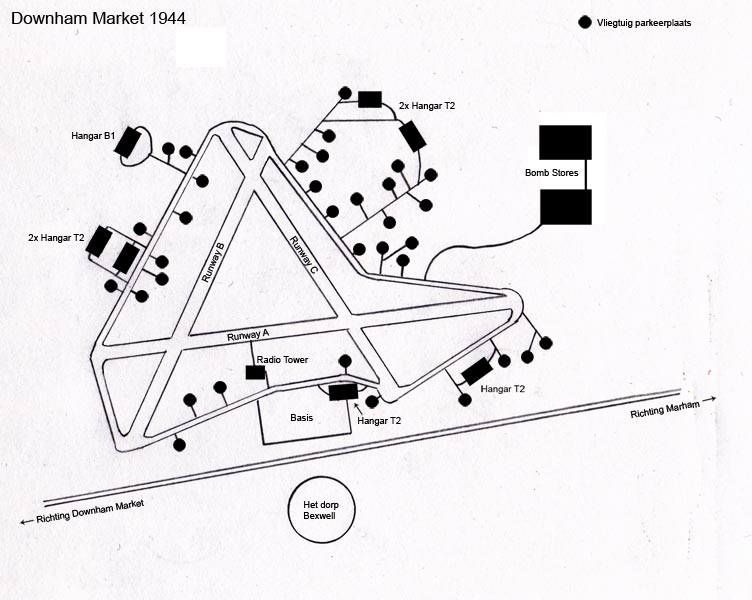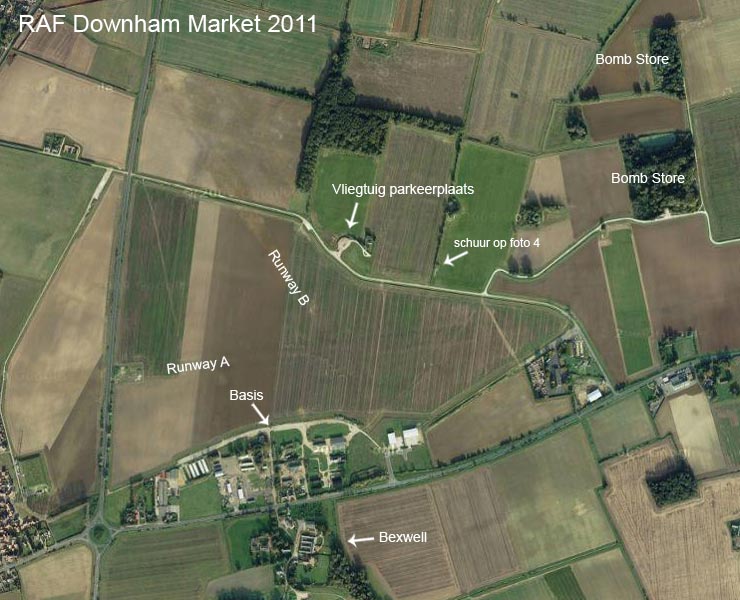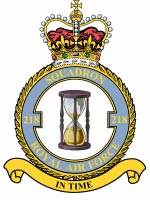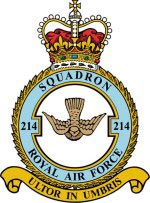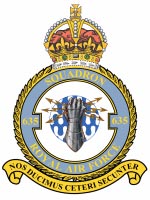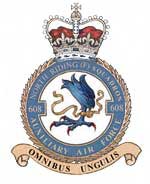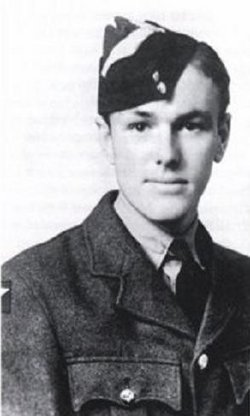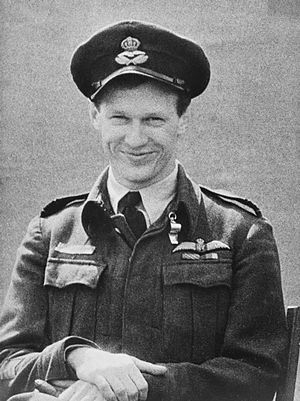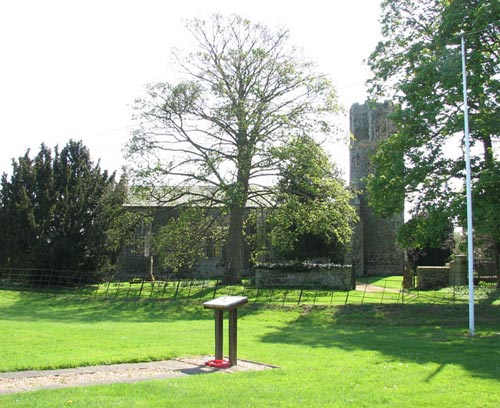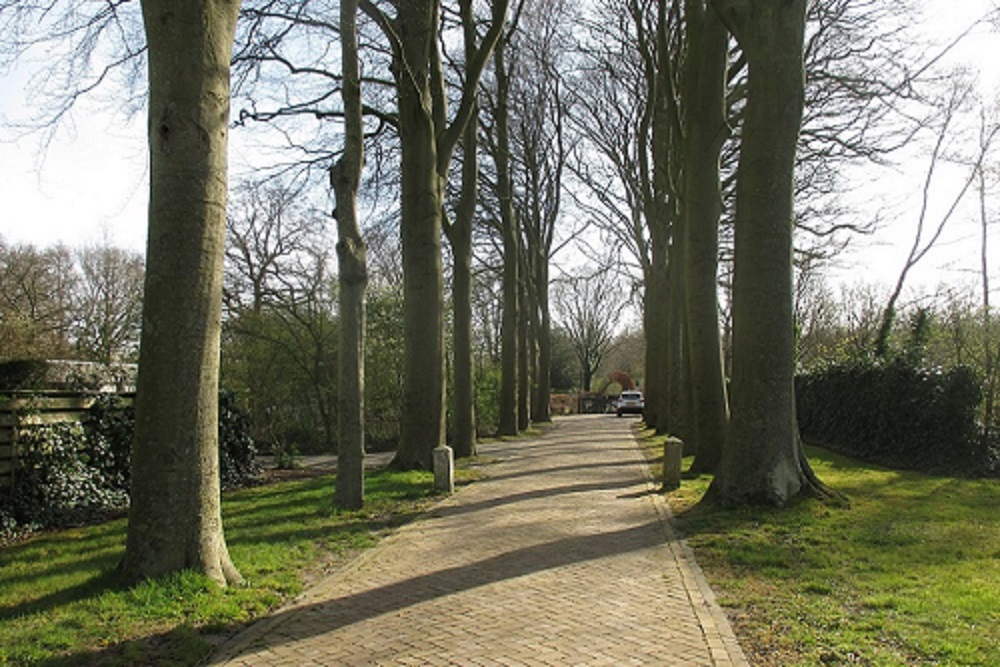General
Introduction
RAF Bomber Command used The Royal Air Force (RAF) base RAF Downham Market during World War Two. Bomber Command executed many bombing missions during World War Two. These missions were aimed at cities and military targets in Germany, Italy and several other occupied countries. RAF Downham Market functioned from its opening in July, 1942 as an auxiliary base for RAF Marham. RAF Marham, which had its origins in the Great War, had become too busy because of the increasing flying movements. RAF Downham Market served as a back-up for the increasing bomber movements so that they could safely land. A fully equipped squadron was transferred from RAF Marham to RAF Downham Market. Two months before the airfield was opened, the first aircraft had landed.
On 30 May 1942, during the famous "1,000 Bomber Raid" (Operation Millennium) on Cologne, the landing strips on RAF Downham Market were used. Because of the busy circumstances on RAF Marham by the simultaneous returning of the many bombers, three bombers stationed at RAF Marham were diverted to RAF Downham Market. This happened again two days later, during the second "1,000 Bomber Raid", this time on the city of Essen. In this case the bombers were diverted to RAF Downham Market because the landing strips at RAF Marham were blocked by damaged bombers. The bombardment on Cologne was, as a matter of fact, the baptism of fire for RAF Downham Market, because it was the first time that flight movements took place from the airfield.
Like many British air force bases, the name was derived from the nearby village, in this case Downham Market in Norfolk. The village owes its name to the market function it had since the Middle Ages. RAF Downham Market was equipped with concrete runways and landing grounds. These were equipped in September, 1943 with Fog Investigation and Dispersal Operation (FIDO), a system that made the landing strip better visible from the air. Because of this, the airfield was up to the newest standards of that time.
Layout of the airfield
In 1942, the construction of RAF Downham Market began. The construction was in the hands of construction company W & C French Ltd., that delivered the airfield in the summer of 1942. Three concrete runways and landing strips were constructed. The horizontal runway, Runway A, was 1,740 meters long and ran parallel to the base. The two diagonal runways, Runway B and C, were 1,290 meters each. Downham Market was the second airfield that was equipped with the FIDO-system and remained one of the few until the end of the war. The system was capable of reducing the fog so that landing aircraft had a better view of the landing ground. The system was constructed in September and the first tests were conducted in October. Sometime later it became operational and until the end of the war 161 airplanes on their return to Downham Market were aided by the FIDO-system.
The operation of FIDO was fairly simple. Along the landing strip, two tubes with burners on top were installed, they were connected by a transverse tube at the end. Petrol was pumped through these tubes. The petrol was subsequently ignited in which illuminated lines parallel to the landing strips were created. The heat of the burners ensured that the landing strip was visible from an altitude of 1,000 meters, even during particularly bad weather and fog. The consumption of petrol was huge: it consumed approximately 450,000 litres per hour. Landing with FIDO was, for many pilots, a frightening experience. The turbulence caused by the heat and the possibility of leaking fuel from the often damaged bombers could obviously cause dangerous situations.
On the base, a number of hangars was built. Between 1942 and 1943, six hangars were built of the type T2 and later one of the type B1, both types being rectangular with a pointed roof. Three of these hangars were used for the storage of Gliders (sailplanes), that were used in operation Market Garden. The remainder of the hangar served for parking and reparation of aircraft. The hangars of the types T2 and B1 were spread out over the airbase. On the terrain, 36 parking lots were constructed for the aircraft, two of which were later removed because of the construction of the B1 hangar in the north-western corner of the terrain. Further, the airfield consisted of a number of auxiliary buildings among which was a bomb store, a concrete building that was used as a stockroom of bombs. This bomb store lay in a safe distance of the base. On the base, a total of nine accommodations for lodging 1,719 men and 326 women was present.
Definitielijst
- Bomber Command
- RAF unit which controlled strategic and sometimes tactical bombing (as in Normandy)
- heat
- High-explosive anti-tank warhead. Shaped charge projectile to punch through armour. Used in e.g. bazooka or in the Panzerfaust.
- RAF
- Royal Air Force. British air force
- Raid
- Fast military raid in enemy territory
- squadron
- A military unit in the Belgian navy usually six to eight small ships operating together under one command. The smallest military unit in the Dutch air force of about 350 men. In most countries is the designation of a military unit thesize of a company. It is either an independent unit, such as a battery, or part of a bigger Calvary unit. In the air force it is the designation of a unit of aircrafts.
Images
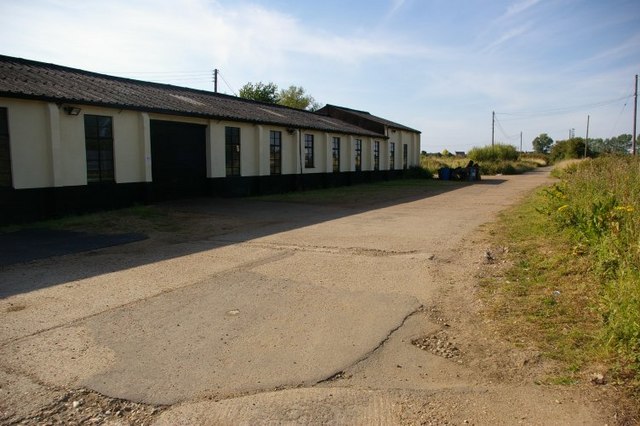 This building is outside the base and was part of a large number of buildings build south of the base.They served as shelter for the staff, dorms and if first aid center. Source: www.geograph.org.uk.
This building is outside the base and was part of a large number of buildings build south of the base.They served as shelter for the staff, dorms and if first aid center. Source: www.geograph.org.uk.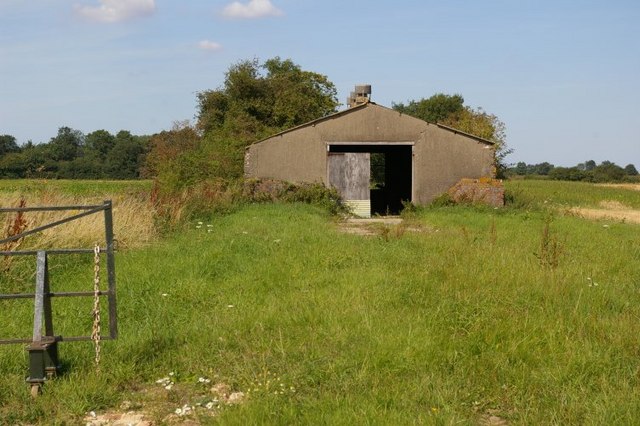 A barn that belonged to the airfield. Source: www.geograph.org.uk.
A barn that belonged to the airfield. Source: www.geograph.org.uk. Newsreel about Fog Investigation And Dispersal Operation (FIDO). Source: YouTube.
Newsreel about Fog Investigation And Dispersal Operation (FIDO). Source: YouTube.Squadrons
Many British airfields were alternately used by various squadrons. Often, other squadrons from other countries of the Commonwealth and the United States or other allies were stationed. RAF Downham Market was solely used by the British RAF. This does not imply that only British were active on RAF Downham Market. Airmen from different nationalities were stationed at RAF Downham Market, but they served in a British squadron.
No. 218 Squadron RAF
Badge: In Time
Active at Downham Market: from 7 July 1942 until 7 March 1944.
Number of executed operational sorties from Downham Market: 1,787.
Number of aircraft lost during these operational sorties: 77.
Aircraft used: Short Stirling I
On 7 July 1942, the airfield was used by the British No. 218 Squadron of the No. 3 Group of the Royal Air Force (RAF) Bomber Command for the first time. This squadron had been transferred from the airbase RAF Marham. During the entire stay at RAF Downham Market, the heavy bomber Short Stirling was flown.
No. 623 Squadron RAF
No badge
Active at Downham Market: from 10 August 1943 until 7 December 1943.
Number of operational sorties from Downham Market: 137.
Number of aircraft lost during these operational sorties: 10.
Aircraft used: Short Stirling III.
No. 623 Squadron of the No. 3 Group of the Royal Air Force (RAF) Bomber Command, was established at Downham Market on 10 August 1943. After only four months, this squadron was dissolved because squadrons of Bomber Command would progressively be equipped with the Avro Lancaster heavy bomber. The vulnerable Stirlings used by No. 623 Squadron were later redeployed for less dangerous missions within Bomber Command, like mine laying. Also, a number was transferred to RAF Transport Command. In total, during bombing raids by No. 623 Squadron, 10 Stirlings were lost while only having executed 137 operational sorties from this airfield. This was a very high loss rate.
No. 214 Squadron RAF
Badge: Ultor in umbris
Active at Downham Market: 10 December 1943 until 16 January 1944.
Number of executed operational sorties from Downham Market: 36.
Number of airplanes lost during these operational sorties: 0.
Aircraft used: Short Stirling III.
For a short while, No. 214 Squadron of the No. 3 Group of the Royal Air Force (RAF) Bomber Command came from RAF Chedbourg to Downham Market to support No. 218 Squadron on a temporary base. On 16 January 1944, the squadron was transferred to RAF Sculthorpe.
No. 635 Squadron RAF
Badge: Nos ducimus ceteri secunter
Active at Downham Market: 20 March 1944 until 1 September 1945.
Number of executed operational sorties from Downham Market: 2,099.
Number of airplanes lost during these operational sorties: 41.
Aircraft used: Avro Lancaster
On 8 March, 1944, after the departure of No. 218 Squadron, the base was taken over by the No. 8 Group. From the No. 8 Group, some crews of the Squadrons No. 35 and No. 97 were transferred to RAF Downham Market. They formed the newly established No. 635 Squadron on 20 March 1944. This squadron was equipped with new Lancaster bombers and was operational on Downham Market until the end of the war.
No. 571 Squadron RAF
No badge.
Active at Downham Market: 7 April 1944 until 24 April 1944.
Number of executed operational sorties from Downham Market: 0.
Number of aircraft lost during these operational sorties: 0.
Aircraft used: De Havilland Mosquito.
For a short while, No. 571 squadron was stationed at RAF Downham Market. This squadron flew de Havilland Mosquitoes. This squadron, which was established at Downham Market, was only present here for 17 days. The squadron did not fly any operational flights from RAF Downham Market. It left for RAF Oakington on 24 April 1944.
No. 608 Squadron RAF
Badge: Omnibus ungulis
Active at Downham Market: 1 August 1944 until 1 September 1945.
Number of executed operational sorties from Downham Market: 1,685.
Number of aircraft lost during these operational sorties: 11.
Aircraft used: de Havilland Mosquito.
On 1 August 1944, the last squadron was assigned to the base. This was No. 608 Squadron RAF Light Night Striking Force (LNSF). This squadron which operated as a Pathfinder Force, flew with Canadian build de Havilland Mosquitoes. Their aim was to mark areas that had to be bombed by using flares. The following formation of Lancaster bombers used the flares to aim their payload. By using the Pathfinders the accuracy of the bombardments was increased significantly. No. 608 Squadron also flew several tactical bombing missions by only using Mosquitoes.
Definitielijst
- Bomber Command
- RAF unit which controlled strategic and sometimes tactical bombing (as in Normandy)
- Commonwealth
- Intergovernmental organisation of independent states in the former British Empire. A bomber crew could include an English pilot, a Welsh navigator, air gunners from Australia or New Zealand. There were also non-commonwealth Poles and Czechs in Bomber Command.
- mine
- An object filled with explosives, equipped with detonator which is activated by either remote control or by colliding with the targeted object. Mines are intended to destroy of damage vehicles, aircrafts or vessels, or to injure, kill or otherwise putting staff out of action. It is also possible to deny enemy access of a specific area by laying mines.
- Pathfinder Force
- Unit flying ahead of the bombers to locate and mark the target with flares to enable the following bombers to drop their bombs at the pre-set time, height and course from the target.
- RAF
- Royal Air Force. British air force
- squadron
- A military unit in the Belgian navy usually six to eight small ships operating together under one command. The smallest military unit in the Dutch air force of about 350 men. In most countries is the designation of a military unit thesize of a company. It is either an independent unit, such as a battery, or part of a bigger Calvary unit. In the air force it is the designation of a unit of aircrafts.
Images
Victoria Cross and after the war
Victoria Cross
Two Victoria Crosses were awarded to airman that were stationed at Downham Market. The first was awarded to Flight Sergeant Arthur Louis Aaron. Aaron was severely wounded during a bombing raid on Turin on 12 August 1943 and he struggled to land the heavily damaged aircraft safely. He first tried to control the plane with all his remaining force. When he could no longer continue controlling the bomber he gave his bombardier instructions how to land the aircraft, who had taken upon himself the task of steering the aircraft. Aaron died of exhaustion nine hours after the aircraft was landed. The courage, determination and leadership that were needed as he balanced on the edge of death is what brought him the Victoria Cross posthumously.
The second Victoria Cross was rewarded on 4 August 1944 to the Canadian Squadron Leader Ian Willoughby Bazalgette. During a bombing raid on the French town Trossy St.Maximin, the aircraft caught fire after it had been hit by Flak antiaircraft fire. Despite the burning of the aircraft and the fact that the bombardier had been hit during the impact, Bazalgette finished his mission first. After the bombs were dropped at the target, the bomber got out of control. Bazalgette managed to regain control over the aircraft, but after an engine dropped out he ordered everyone on board to leave the aircraft by parachute. The wounded bombardier and the wounded air gunner remained behind in the aircraft as they were not able to bail out. Bazalgette managed to land the bomber safely, but it exploded on the ground. During the explosion the three crew members, including Bazalgette, lost their lives. He was rewarded the Victoria Cross posthumously for his valour.
After the war
The final bombing raid on Germany that was executed during World War Two was flown from Downham Market on 2 May 1945. It was a bombing raid on the harbours of Kiel. This mission was executed by No. 608 Squadron. After the war, food dropping raids were executed in the west of the Netherlands from RAF Downham Market. Also The squadron also brought British former POWs back to their country. In May and June, the ground personnel of RAF Downham Market got the opportunity to fly over the ruins of German cities in a Lancaster. They could see the results of their work of the last years. Also the bomber crews that had executed the missions saw for the first time what damage they had inflicted during their raids as most of the time they had only flown at night. The squadrons No. 608 and No. 635 were dissolved in September 1945, after which RAF Downham Market remained in use by the RAF for some time. There was, however, not much activity and it was decided to close the base on 24 October 1946. At the present moment, the airfield is hardly visible from the air. The runways have been turned into farming land, only Runway A and B are still faintly visible. Only a couple of old airbase buildings remain. The base and bomb stores are still clearly visible nowadays.
In commemoration of the killed airmen that were stationed at RAF Downham Market, there are two monuments in the vicinity of the former base. One is in the village of Bexwell, this was located directly opposed the former airfield. It is the RAF Victoria Cross Memorial. This monument commemorates all crews stationed at Downham Market that died during World War Two, with special attention to the two recipients of the Victoria Cross, Flight Sergeant Arthur Louis Aaron and Squadron Leader Ian Willoughby Bazalgette. In the St. Mary’s Church in Bexwell a plaque can be found commemorating all Downham market airmen that died during World War Two.
Definitielijst
- Flak
- Flieger-/Flugabwehrkanone. German anti-aircraft guns.
- RAF
- Royal Air Force. British air force
- raid
- Fast military raid in enemy territory
- Squadron
- A military unit in the Belgian navy usually six to eight small ships operating together under one command. The smallest military unit in the Dutch air force of about 350 men. In most countries is the designation of a military unit thesize of a company. It is either an independent unit, such as a battery, or part of a bigger Calvary unit. In the air force it is the designation of a unit of aircrafts.
Images
Information
- Article by:
- Paul Moerenhout
- Translated by:
- Peter ter Haar
- Published on:
- 19-01-2025
- Feedback?
- Send it!
Related sights
Sources
- FREEMAN, R.A., Bases of Bomber Command Then and Now, After the Battle, London, 2001
- HILLING, J.B., Strike Hard, A Bomber Airfield at War, RAF Downham Market and Its Squadrons 1942-46, Alan Sutton Publishing, Ltd., Phoenix Mill, Stroud, Gloucestershire, 1997.
- INNES, G.B., British Airfield Buildings of the Second World War, Midland Publishing, Earl Shilton, Leicester, 1997.
- KELVE, D, The Military Airfields of Britain, Northern England, Co Durham, Cumbria, Isle of Man, Lancashire, Merseyside, Manchester, Northumberland, Tyne and Wear,, The Crowood Press Ltd, Ramsbury, 2006.
- Defence Works Functional Standards FS16, Guide to World War II Hangars 02
- Type T2 Hangars, Ministry of Defence, March 1995
- WW2Awards.com: Aaron, Arthur Louis
- WW2Awards.com: Bazalgette, Ian Willoughby
- wiki.familysearch.org
- www.historyofwar.org
